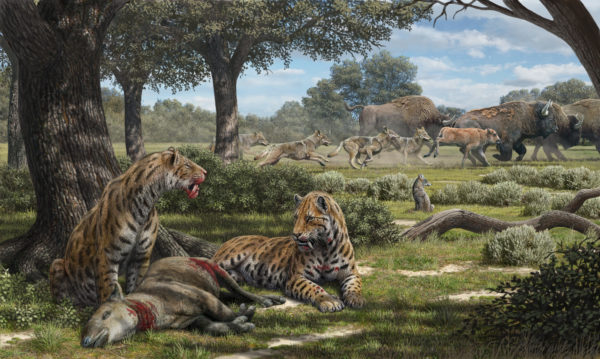Intense take a look at La Brea Tar Pits explains why we've got coyotes, not saber-toothed cats | Vanderbilt Information
[ad_1]
Probably the most detailed examine so far of historical predators trapped within the La Brea Tar Pits helps People perceive why at present we’re coping with coyotes dumping over rubbish cans and never saber-toothed cats ripping our arms off.
Larisa DeSantis, a Vanderbilt College paleontologist, grew up visiting the one-of-a-kind fossil web site in Los Angeles, which incorporates fossils of predators that attempted to eat horses, bison and camels caught within the tar over the previous 50,000 years and themselves grew to become trapped, providing one of the best alternative to grasp Ice Age animals going through local weather change. The Pleistocene Epoch spanned 2.6 million years in the past to about 10,000 years in the past, encompassing a number of glacial and interglacial durations and the arrival of people, one or each of which compelled predators to adapt their diets or die.

DeSantis spent the final decade visiting La Brea, learning the tooth of extinct species corresponding to American lions, saber-toothed cats and dire wolves; and tooth from historical animals whose offspring are nonetheless alive at present, corresponding to grey wolves, cougars and coyotes. Her work revealed that competitors for prey amongst carnivores wasn’t a probable reason for the Pleistocene megafaunal extinction as previously believed, as a result of, like canines and cats of at present, one most well-liked working after herbivores within the open fields, whereas the opposite most well-liked stalking them in forested areas.
“Isotopes from the bones beforehand steered that the diets of saber-toothed cats and dire wolves overlapped utterly, however the isotopes from their tooth give a really completely different image,” mentioned DeSantis, an affiliate professor of organic sciences at Vanderbilt. “The cats, together with saber-toothed cats, American lions and cougars, hunted prey that most well-liked forests, whereas it was the dire wolves that appeared to specialize on open-country feeders like bison and horses. Whereas there might have been some overlap in what the dominant predators ate up, cats and canines largely hunted in another way from each other.”
To review these historical predators, she employs dentistry — taking molds of the tooth and shaving off tiny bits of enamel for chemical evaluation. Details about all the pieces the animal ate lies inside the isotopes, she mentioned. Additional, the microscopic put on patterns on tooth can make clear who was consuming flesh or scavenging on bones.
It’s seemingly that these large predators went extinct on account of local weather change, the arrival of people to their surroundings or a mixture of the 2, she mentioned, and her crew is working to make clear the reason for the extinction with a number of colleagues throughout six establishments as a part of a separate on-going examine.
What they know is predators alive at present within the Americas had been higher in a position to adapt their diets. As a substitute of solely feeding on giant prey, they may successfully hunt small mammals, scavenge what they may from carcasses or do each.

“The opposite thrilling factor about this analysis is we are able to really take a look at the results of this extinction,” DeSantis mentioned. “The animals round at present that we consider as apex predators in North America — cougars and wolves — had been measly throughout the Pleistocene. So when the massive predators went extinct, as did the massive prey, these smaller animals had been in a position to reap the benefits of that extinction and develop into dominant apex-predators.”
An much more detailed image of historical life at La Brea is contained within the paper “Causes and penalties of Pleistocene megafaunal extinctions as revealed from Rancho La Brea mammals,” printed at present within the journal Present Biology.
The work was supported by Nationwide Science Basis grant EAR1053839.
[ad_2]
Supply hyperlink